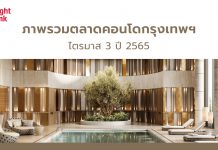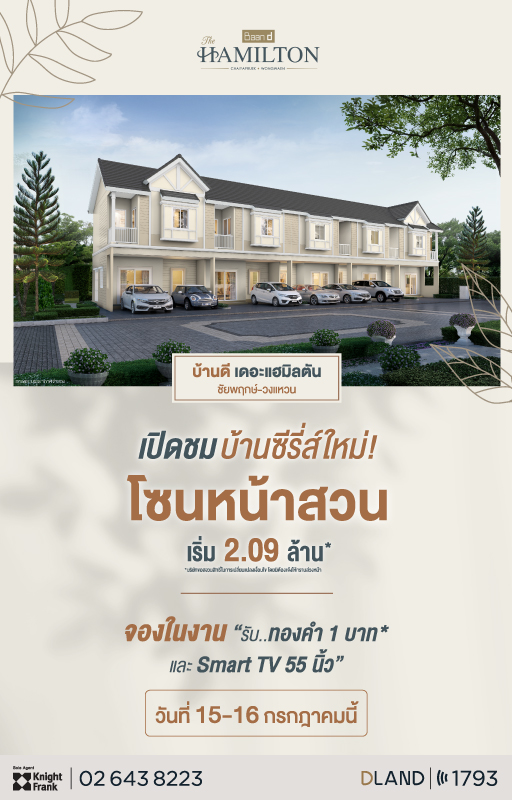The connectivity of the MRT’s Blue Line between Bangsue and Tao Poon Stations on 11 August 2017 positively impacted the rail transportation infrastructure of Bangkok’s northern zone, making travel more convenient and comfortable. In particular, it afforded a direct linkage between the Blue Line and the Purple Line at Tao Poon Station, which significantly boosted the transport system efficacy and thus residential appeal of the area. This is coupled with the development plan of land surrounding Bangsue (Phaholyothin Transportation Centre) of the State Railway of Thailand, which controls roughly 2,325 rai; the Ministry of Transport and Communications plans to develop such land commercially along the framework of Transit Oriented Development (TOD) to become a mixed-use development around the high-speed railway station. Ultimately, the area will become a hub of activity for urban dwellers of all genders and ages, in terms of places for work, living, shopping, maintaining health, and recreation. The aim of Transit Oriented Development (TOD), in addition to creating a centre of activity around the huge mass transit station that can be conveniently accessed by large groups of people, is to increase the quality of life for people in the city, boost the usage rate of the mass transit system, and reduce the use of private cars and thus greenhouse gas emissions. As such, Transit Oriented Development (TOD) is considered to be an important project for modern living, taking into account both economic development and environmental feasibility for greater sustainability well into the future.
When the area around the station has been developed, there will be significant movement as well as settling down of people, which will then lead to residential developments in a range of formats around the station and its vicinity to meet the heightened demand for residential spaces. From studies conducted by Knight Frank Thailand’s research department, it was found that many countries, including the United States, Canada, Brazil, France, the Netherlands, Australia, Hong Kong, and Japan, which embarked on Transit Oriented Development (TOD), were successful in raising the values of land and property around their large-scale mass transit stations. In the example of the United States, the value of such land and property increased by 150 per cent. The rise in value will, of course, vary from place to place, depending on each locality’s environmental laws, city planning, and level of connectivity provided by the mass transit system. In addition, the national and regional economies at the time of development also play a role in the success.
From the above, Transit Oriented Development (TOD) marks one approach to urban development, which eventually affects real estate development in a continuous way. In Thailand, the plans for commercial development of Bangsue Central Station (Phaholyothin Transportation Centre) cover 300 rai; there will also be up to 4 rail lines meeting here, namely, the Blue Line, Purple Line, Dark Red Line, and Light Red Line. All 4 lines will shuttle massive amounts of people to and from Bangsue (Phaholyothin Transportation Centre), which will bring about huge changes, revitalising the immediate and surrounding urban areas, part of the aim of Transit Oriented Development (TOD). The development of Bangsue station (Phaholyothin Transportation Centre) will not only transform the Tao Poon – Bangsue cityscape, which was formerly a community residential area, it will propel Bangsue station into the very important role as a catalyst that will change the framework of the property development market in northern Bangkok and its surrounding areas.
The development of Bangsue station (Phaholyothin Transportation Centre) encompasses 4 zones, including:
- Zone A (Smart Business Complex) – Located on 35 rai to the south of the station, this zone will be developed as a transportation hub that meets international standards. It will also serve as a comprehensive business complex, with office buildings, logistics services, a retail space, a food centre, and a hotel, catering to the needs of both business people and leisure travellers.
- Zone B (ASEAN Commercial and Business Hub) – Comprising 78 rai, this zone is located on the eastern side of the station, just 700 metres from Chatuchak Market. It is to be used as an ASEAN commercial and business area, with a huge shopping space to complement to the offerings of Chatuchak Market. In addition, this zone will also house office buildings, a hotel, a condominium, a serviced apartment, and a convention and exhibition hall. The aim is to become a comprehensive business hub.
- Zone C (Smart Healthy and Vibrant Town) – Encompassing 105 rai, this zone will occupy the land of The Transport Co., Ltd. (currently Mo Chit 2 Station). This will be a residential, work, retail, and recreational zone, developed in such a way that supports healthy urban living.
- Zone D (World Renowned Garden Interchange Plaza) – On 5 rai, this zone is adjacent to Chatuchak Market. It will become a large interchange zone among the transport modes, boasting retail spaces.
Image 1: Commercial Development Plans/Phaholyothin Transportation Centre

Source: Ministry of Transport and Communications
Bangsue Central Station (Phaholyothin Transportation Centre) is expected to open in 2020. It will be the largest transportation centre in Thailand, as well as a trade and business hub in Bangkok. In addition, the station will serve as a model, when appropriate, for Transit Oriented Development (TOD) for areas located around high-speed railway stations. At present, many private parties feel confident about the project and have invested in the Tao Poon – Bangsue area and its vicinity. Given that the project connects the Blue Line and Purple Line, along with its future prospects as Thailand’s largest transportation centre and Bangkok’s business hub, the Bangsue area has attracted real estate projects that are currently under construction by large-scale developers, including condos and commercial projects such as Gateway Bangsue from TCC Land Asset World Co., Ltd. The latter is situated just 650 metres from Tao Poon Station, with an investment of over 4 billion baht and around 40,000 square metres of retail space. It is slated to open in 2018, and expected to elevate Bangsue – Tao Poon further as an area that’s worth watching from both the property investor and owner standpoints.














